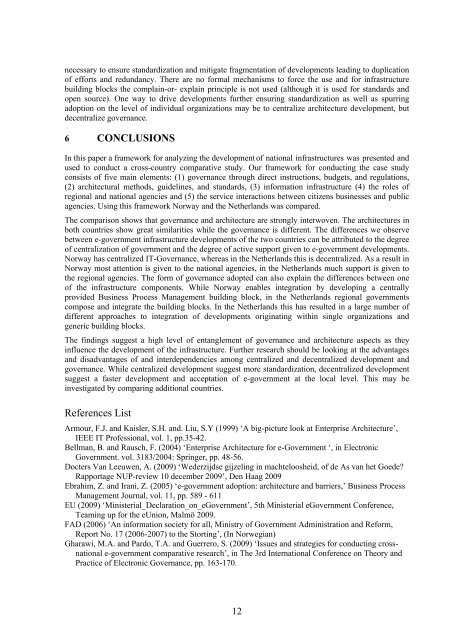Multi-channel provisioning of public services - Department of ...
Multi-channel provisioning of public services - Department of ...
Multi-channel provisioning of public services - Department of ...
You also want an ePaper? Increase the reach of your titles
YUMPU automatically turns print PDFs into web optimized ePapers that Google loves.
necessary to ensure standardization and mitigate fragmentation <strong>of</strong> developments leading to duplication<br />
<strong>of</strong> efforts and redundancy. There are no formal mechanisms to force the use and for infrastructure<br />
building blocks the complain-or- explain principle is not used (although it is used for standards and<br />
open source). One way to drive developments further ensuring standardization as well as spurring<br />
adoption on the level <strong>of</strong> individual organizations may be to centralize architecture development, but<br />
decentralize governance.<br />
6 CONCLUSIONS<br />
In this paper a framework for analyzing the development <strong>of</strong> national infrastructures was presented and<br />
used to conduct a cross-country comparative study. Our framework for conducting the case study<br />
consists <strong>of</strong> five main elements: (1) governance through direct instructions, budgets, and regulations,<br />
(2) architectural methods, guidelines, and standards, (3) information infrastructure (4) the roles <strong>of</strong><br />
regional and national agencies and (5) the service interactions between citizens businesses and <strong>public</strong><br />
agencies. Using this framework Norway and the Netherlands was compared.<br />
The comparison shows that governance and architecture are strongly interwoven. The architectures in<br />
both countries show great similarities while the governance is different. The differences we observe<br />
between e-government infrastructure developments <strong>of</strong> the two countries can be attributed to the degree<br />
<strong>of</strong> centralization <strong>of</strong> government and the degree <strong>of</strong> active support given to e-government developments.<br />
Norway has centralized IT-Governance, whereas in the Netherlands this is decentralized. As a result in<br />
Norway most attention is given to the national agencies, in the Netherlands much support is given to<br />
the regional agencies. The form <strong>of</strong> governance adopted can also explain the differences between one<br />
<strong>of</strong> the infrastructure components. While Norway enables integration by developing a centrally<br />
provided Business Process Management building block, in the Netherlands regional governments<br />
compose and integrate the building blocks. In the Netherlands this has resulted in a large number <strong>of</strong><br />
different approaches to integration <strong>of</strong> developments originating within single organizations and<br />
generic building blocks.<br />
The findings suggest a high level <strong>of</strong> entanglement <strong>of</strong> governance and architecture aspects as they<br />
influence the development <strong>of</strong> the infrastructure. Further research should be looking at the advantages<br />
and disadvantages <strong>of</strong> and interdependencies among centralized and decentralized development and<br />
governance. While centralized development suggest more standardization, decentralized development<br />
suggest a faster development and acceptation <strong>of</strong> e-government at the local level. This may be<br />
investigated by comparing additional countries.<br />
References List<br />
Armour, F.J. and Kaisler, S.H. and. Liu, S.Y (1999) ‘A big-picture look at Enterprise Architecture’,<br />
IEEE IT Pr<strong>of</strong>essional, vol. 1, pp.35-42.<br />
Bellman, B. and Rausch, F. (2004) ‘Enterprise Architecture for e-Government ‘, in Electronic<br />
Government. vol. 3183/2004: Springer, pp. 48-56.<br />
Docters Van Leeuwen, A. (2009) ‘Wederzijdse gijzeling in machteloosheid, <strong>of</strong> de As van het Goede?<br />
Rapportage NUP-review 10 december 2009’, Den Haag 2009<br />
Ebrahim, Z. and Irani, Z. (2005) ‘e-government adoption: architecture and barriers,’ Business Process<br />
Management Journal, vol. 11, pp. 589 - 611<br />
EU (2009) ‘Ministerial_Declaration_on_eGovernment’, 5th Ministerial eGovernment Conference,<br />
Teaming up for the eUnion, Malmö 2009.<br />
FAD (2006) ‘An information society for all, Ministry <strong>of</strong> Government Administration and Reform,<br />
Report No. 17 (2006-2007) to the Storting’, (In Norwegian)<br />
Gharawi, M.A. and Pardo, T.A. and Guerrero, S. (2009) ‘Issues and strategies for conducting crossnational<br />
e-government comparative research’, in The 3rd International Conference on Theory and<br />
Practice <strong>of</strong> Electronic Governance, pp. 163-170.<br />
12
















